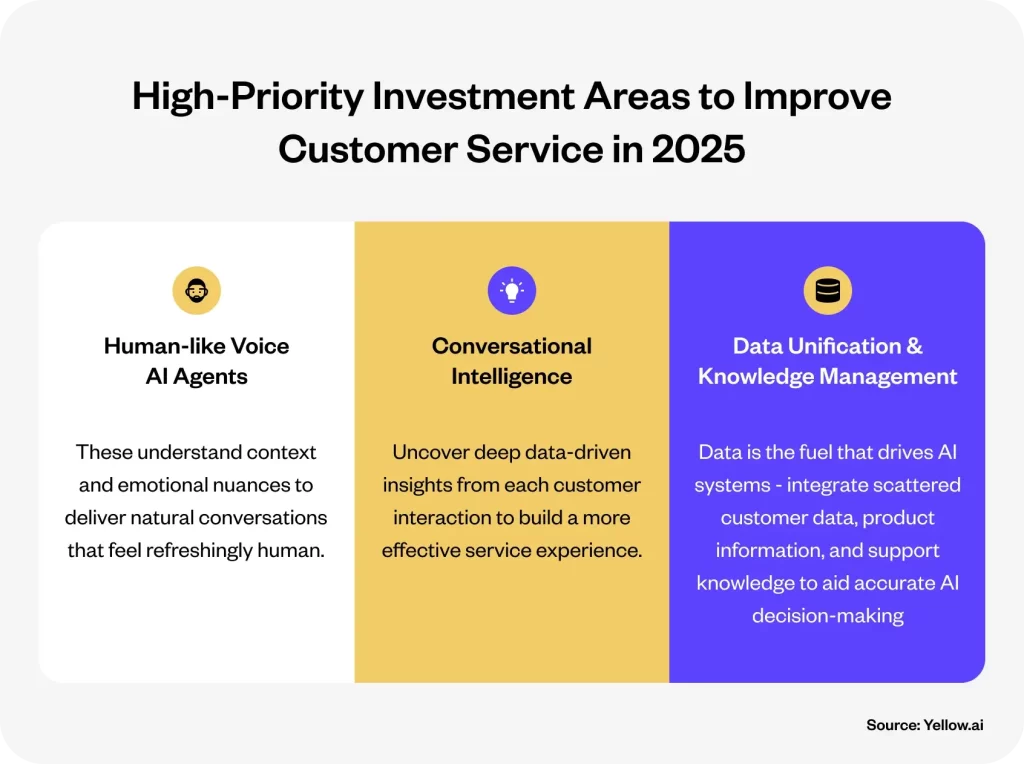Customer service isn’t what it used to be, and that’s a good thing. Why? In 2025, the bar is higher, customer expectations are sharper, and technology has evolved from just helpful add-ons to mission – critical. According to Gartner, by 2026, 60% of current customer service engagements will be handled by generative AI agents, up from less than 5% in 2022. So how should brands be adapting? What still works, what doesn’t, and what should you double down on?
Let’s explore what’s fundamentally changed in customer service, which timeless principles remain crucial, and where you should invest your resources for maximum impact and efficiency.
What’s Changed
The AI Revolution in Customer Experience
Customer service has seen a necessary shift from scripted flows to smart, dynamic interactions. With the rise of conversational AI, interactions are now more context driven and emotionally responsive. This shift is about more than just automation to buy time for human agents to become available to resolve the issue, it’s about creating real value, faster.
- Multi-Modal Intelligence: The Visual-Verbal Advantage
AI solutions today understand not just what customers say, but how they say it. By analyzing voice tone, facial expressions, and textual cues simultaneously, multi-modal AI creates a more natural, intuitive experience across every channel. Customers can now switch seamlessly between showing a problem on camera, uploading an image, or describing their issue verbally, with the AI maintaining contextual awareness throughout.
Quick Tip: When implementing multimodal AI, prioritize use cases where visual or auditory context significantly enhances issue diagnosis and resolution speed.
- GenAI’s Impact on Service Quality and Efficiency
Generative AI is reshaping CX by replacing scripted replies with dynamic and more context – aware answers that evolve in real time. It pulls from enterprise data to generate responses that feel more personalized, relevant, and human, thus improving resolution rates, reducing training time, and setting better standards for consistency and speed. - Agentic AI: The Rise of Autonomous Support Systems
The latest breakthrough that has the potential to take customer service to a completely new level is the emergence of truly autonomous AI agents. These systems don’t just respond to queries, they proactively manage entire customer journeys with minimal human oversight.
Agentic AI can now independently:- Diagnose complex, multi – faceted problems
- Navigate between different knowledge bases and systems
- Make judgment calls within defined parameters
- Learn from each interaction to improve future performances
From Reactive to Predictive: The New Customer Service Paradigm
The most forward – thinking organizations have flipped the traditional support model on its head. Rather than waiting for customers to report their issues, predictive systems can now identify potential problems before they end-up impacting the customer experience.
Proactive support is now a competitive edge. Brands are identifying intent, detecting issues before they escalate, and offering help before customers even ask. Predictive capabilities are shaping a more efficient and surprise – free service experience.By analyzing usage patterns, system signals, and behavioral indicators, these intelligent systems can now intervene at the perfect moment, often resolving issues before customers even realize they exist.

The New Metrics that Matter in 2025
- Autonomous Resolution Rate
Going beyond simple deflection, this metric measures complete issue resolution by AI agents without human intervention. Leading organizations are achieving autonomous resolution rates of 85%+ for tier-1 support issues while maintaining high satisfaction scores. It’s about measuring outcome, not presence.
- Customer Effort Score (CES)
The less work that customers have to do to get their issues resolved, the higher will be their satisfaction and loyalty. In 2025, effortless experiences have become the gold standard, with top performers reducing customer effort by up to 40% through intelligent automation and proactive support. Low-effort experiences directly correlate with customer retention and satisfaction.
- Predictive CSAT
AI now enables real – time forecasting of customer service satisfaction by analyzing sentimental shifts, response cadence, keyword usage, and even silence patterns during live interactions and the customer journey. This allows brands to detect friction early-on, trigger proactive support, and reduce post-interaction survey dependency, turning every conversation into an opportunity for course correction.
- Journey Completion Rate
This metric tracks how often customers successfully complete their intended tasks without dropping off or escalating the conversation. It provides an accurate picture of experience quality than traditional metrics that tend to solely focus on individual touchpoints.
To improve this metric, start by identifying where users are dropping off, whether it’s during specific steps, at certain times, or on particular channels. Then, use guided nudges, context-aware prompts, or proactive AI messages to help customers stay on track and complete their journey with less effort.
- Tracking Emotional Shifts During Support
Teams can now measure how customer sentiment evolves from the start to the end of an interaction in their AI customer support journey. After being detected and measured, this insight can be used to personalize follow-ups, trigger empathy-led agent interventions, or refine AI responses to prevent any similar sentiment dips in future conversations.The goal is to turn frustrated customers into brand advocates via exceptional service. This is a leading indicator of loyalty and brand perception
Impact Insight: Organizations that prioritize emotional state change metrics report 22% higher customer retention rates compared to those focused exclusively on efficiency metrics.
How Does This Help You Go From “Dear <First name>” to Hyper-Personalized Proactive Service
- Contextual Intelligence
Today’s AI systems are built to deliver prompt value with minimal human intervention. They can analyze thousands of data points from your CRM, past conversations, purchase history, and behavior across channels to build comprehensive insights to power responses that feel not just relevant but genuinely human. Whether handling the entire interaction independently or equipping your reps with rich context and guidance, these systems transform generic support into meaningful conversations.
- The Next-Best-Action Guidance
AI support systems now read between the lines of customer inquiries. By analyzing language patterns, navigation history, and the customer’s specific journey, they can provide the most helpful next steps even if customers are not asking for them.When someone inquires about a shipping delay, the AI automatically offers alternatives based on urgency, suggests complementary products addressing underlying needs, and flags potential issues down the road. Human agents access these same insights through real-time suggestion panels, transforming every team member into your most seasoned problem solver.
- Predictive Issue Detection & Resolution for Strategic Lifecycle Management
Today’s AI Agents can detect problems before customers do. By continuously monitoring product telemetry, usage patterns, and error signals, AI identifies emerging issues and triggers automated fixes in real-time. When a customer experiences unusual latency or feature failures, the system can deploy targeted solutions before frustration builds. This capability has transformed traditional “break-fix” support into proactive experience management, with leading companies reporting 60% fewer inbound complaints and 40% higher satisfaction scores through early intervention.
What Still Works
Banking on Human Intuition
AI agents today can handle both volume and nuance in natural conversations. With that the role of the modern human agent has evolved from being frontline responders to strategic relationship managers, using AI to enhance their uniquely human abilities.
- Augmented Agent Assist: Tools That Create Support Superheroes
Today’s most effective agents work alongside AI systems that dramatically amplify their capabilities. Agent Assist tools suggest replies, surface relevant content, and summarise their past interactions. - The Winning Formula: Emotional Intelligence + AI
Today the best service operations have service reps working alongside AI agents that dramatically amplify their human capabilities. These agents provide real-time conversation summaries, suggest personalized responses, surface relevant knowledge, and predict customer needs, enabling them to deliver exceptional service even in the most complex scenarios.
Key insight – AI can scale service capabilities exponentially, but the combination of human creativity with machine precision creates experiences that neither could deliver alone. The most successful support models blend these intelligences seamlessly.
- Continuous Co-learning Environments
Leading support teams globally are increasingly using AI to enhance their reps’ capabilities while the latter simultaneously improves AI performance as well. Through guided evaluations of AI suggestions, strategic overrides of automated responses, and structured feedback loops, both systems grow smarter together. This symbiotic relationship creates a continuously evolving service ecosystem where human judgment and machine precision constantly elevate each other’s capabilities.
Customer – Centric Fundamentals
Clear communication, respect, timely updates and follow-throughs continue to form the core of great and efficient customer service.
- Why First Contact Resolution is Key
In an age of intelligent automation, First Contact Resolution (FCR) continues to be a critical metric. Customers still value having their issues resolved in the initial interaction, regardless of whether this interaction is with an AI agent or a human agent
Key Takeaway – Make it easy for customers to get help, and get it done right the first time.
- The Enduring Value of Effortless and Efficient Omnichannel Experience
Your customers’ time is valuable, they shouldn’t have to waste it repeating themselves. Every conversation should build on previous interactions, not restart them if they switch channels. A unified view of the customer across chat, voice, email, and social ensures continuity and removes friction. Omnichannel Engagement empowers AI and agents to pick up conversations midstream, delivering faster, more personalized support without lost context or delays.
- Building Trust in Automated Interactions
Customers don’t need to understand how AI works, they need to feel confident it’s working for them. The most effective AI agents build confidence through three key elements: predictable accuracy (resolving issues completely on first contact), contextual awareness (remembering preferences without repeated instructions), and emotional attunement (respond with appropriate empathy and energy). Unlike traditional metrics that measure speed, the new standard evaluates how effectively AI makes customers feel understood and valued, turning skeptics into advocates who actively prefer automated assistance for its consistency and personalization.

Where Should You Focus
1. High – Priority Investment Areas
Investing in tools that reduce customer effort, support real-time insights and improve agent productivity is the need of the hour. It is essential to look for solutions that combine automation with orchestration.
- Voice AI 2.0: Beyond Basic Voice Recognition
The next generation of Voice AI delivers natural, human-like interactions without robotic interruptions. It listens smartly, responds at the right moment, and understands intent instantly, ensuring smooth, accurate, and frustration-free conversations. It maintains context across Voice, Chat, Email, and Enterprise Apps, ensuring smooth transitions without losing conversation history. Experience a new age Voice AI, a game changer for improving customer experience. - Conversational Intelligence: When Chatbots Become Strategic Partners
Modern bots don’t just answer questions. With built-in conversational analytics like Yellow.ai’s Analyze Module, you will be able to detect user intent, adjust in real time, and guide the conversation toward meaningful outcomes. They continuously learn from human-agent interactions, improving accuracy and adaptability thus making them valuable partners - Getting the Data Foundation Right
Solid data is the fuel that drives an effective AI-powered ecosystem. Enterprises often struggle because they have large volumes of data but all of it is scattered across disconnected systems, CRM platforms, ticketing software, knowledge bases, product catalogs, transaction histories, and more. The best service platforms integrate data silos into a unified source of truth, structure knowledge in AI-friendly formats with proper taxonomy, and establish automated systems to continuously capture new interactions and product updates in real-time to keep information current
Strategic Insight – Before investing in advanced AI capabilities, ensure that your data foundation can support them. Companies that prioritize data foundation work before rushing AI deployment typically achieve 4x higher customer satisfaction with their automated systems compared to those that neglect this critical step.
2. Common Implementation Challenges to Address
- Building the Business Case and Budget Constraints
Securing investment for optimal customer service transformation requires demonstration of clear ROI. Focusing on quick wins like deflection rates, agent productivity and CSAT uplift can build compelling business cases for your initiatives and help in proving value early.
Need help with stakeholder buy-in? From setting the right success metrics to speaking your CFO’s language, our latest Guide to Stakeholder Alignment Success breaks down how to build the internal momentum you need.
- Managing the transition from Legacy Systems
AI agent integration, with the right providers, doesn’t have to mean going through rip-and-replace exercises, which can be an expensive nightmare in a complex enterprise scenario. Today, advanced automation platforms are designed to enhance rather than replace your technology investments, offering pre-built integrations that dramatically reduce deployment time and complexity. This protect-and-enhance approach means you can preserve your existing infrastructure, while having the time to value through rapid automation. - Managing Change and Employee Adoption
Investing in comprehensive and well-rounded change management programs that address staff concerns, provide clear training and communicate how AI will enhance focus on fast and relevant responses, personalized interactions, data privacy and a seamless and well-integrated omnichannel experience
3. Implementation Roadmap: Transforming Your Service Experience in 90 days
- Stage 1: Prioritize & Align (Days 1–30)
- Identify the Impossible Ask: Clarify your most critical CX outcomes – e.g., 24/7 service, multilingual support, or deflection without losing empathy.
- Get Cross-Functional Buy-In: Involve CX, IT, and Finance early. Leaders who drive alignment here see faster time-to-value.
- Pick High-Impact Use Cases: Start with one or two clear problem areas, billing queries, order tracking, etc, that are easy to automate and deliver ROI.
- Stage 2: Launch & Learn (Days 31–60)
- Deploy in the Flow of Work: Roll out AI agents across real channels (web, WhatsApp, voice) where customer volume is high.
- Integrate & Automate: Connect to CRM, order systems, and other backends to ensure seamless transactions.
- Observe Interactions Closely: Use analytics to measure drop-offs, frustration points, and resolution rates.
- Stage 3: Optimize & Scale (Days 61–90)
- Fine-Tune Conversations: Use real-world data to train and optimize AI responses for empathy, context, and efficiency.
- Expand Horizontally: Add new channels (voice, app) and new intents (returns, escalations) as confidence grows.
Conclusion: Designing Customer Service for Lasting Impact
Good Customer service in 2025 is both equal parts tech and trust. The most successful service organizations have moved beyond viewing technology and human service as separate components. It’s about leveraging AI to do more than automate, to elevate every customer interaction. The brands that win will be those who can combine empathy and efficiency, prediction and personalization.It’s time to evolve your support strategy.
See how global enterprise leaders are scaling customer service with AI agents today.























